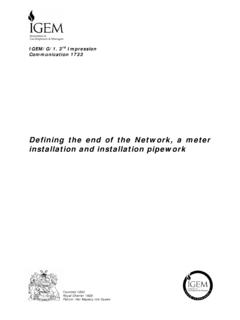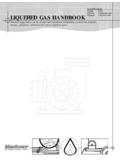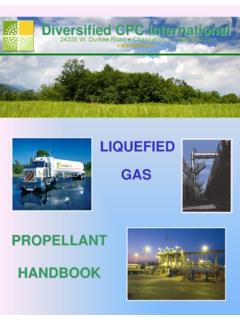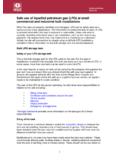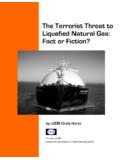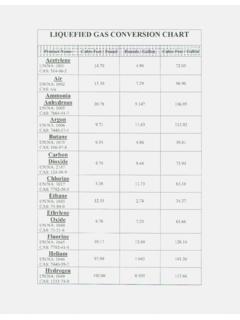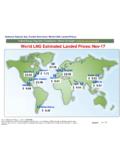Transcription of Tightness testing and direct purging of small Liquefied ...
1 Founded 1863 Royal Charter 1929 Patron: Her Majesty the Queen IGEM/UP/1B Edition 3 Communication 1759 Tightness testing and direct purging of small Liquefied Petroleum Gas/Air, NaturalGas and Liquefied Petroleum Gas installations Price Code: C4S The Institution of Gas Engineers and ManagersIGEM HouseHigh StreetKegworthDerbyshire, DE74 2 DATel: 0844 375 4436 Fax: 01509 678198 Email: IGEM/UP/1B Edition 3 Communication 1759 Tightness testing and direct purging of small Liquefied Petroleum Gas/Air, NaturalGas and Liquefied Petroleum Gas installations Copyright 2012, IGEM. All rights reserved Registered charity number 214001 All content in this publication is, unless stated otherwise, the property of IGEM. Copyright laws protect this publication. Reproduction or retransmission in whole or in part, in any manner, without the prior written consent of the copyright holder, is a violation of copyright law.
2 ISBN 978 1 905903 34 4 ISSN 0367 7850 Published by the Institution of Gas Engineers and Managers Previous Publications: Communication 1675 (2002) 1st Edition Communication 1714 (2006) 2nd Edition For information on other IGEM Standards please visit our website, IGEM/UP/1B Edition 3 IGEM, IGEM House, High Street, Kegworth, Derbyshire, DE74 2DA. Website: CONTENTS SECTION PAGE 1 Introduction 1 2 Scope 5 3 Legal and allied considerations 8 4 Test equipment and criteria 9 Test equipment 9 Test criteria 10 5 Tightness testing 11 Strength testing 11 General 11 Tightness testing procedures 12 LPG/Air mixtures 12 Natural Gas 17 LPG 21 New extensions/alterations to existing installations 26 Dealing with suspect gas escapes 26 6 direct purging to fuel gas 27 General 27 Installation volume and purge volume 27 purging procedures 28 LPG/Air mixtures 28 Natural Gas 29 LPG
3 31 Safety precautions 32 APPENDIX 1 Glossary, acronyms, units, symbols and subscripts 33 2 References 35 3 Tightness testing new installations with air 37 4 Tightness testing existing NG installations for 75 mbar < MOPu 2 bar without a meter inlet valve (MIV) 39 5 Recognising regulator sets 42 6 LPG installation types 47 7 Estimating installation volume (IV) and purge volume (PV) 51 8 Maximum permissible pressure drops for existing LPG installations with 57 appliances connected IGEM/UP/1B Edition 3 IGEM, IGEM House, High Street, Kegworth, Derbyshire, DE74 2DA. Website: FIGURE 1 Algorithm to select testing and purging standards 3 2 Relative pressure levels 4 3 Typical installations 7 4 Flow diagram for Tightness testing LPG/Air installations 16 5 Flow diagram for Tightness testing NG installations 20 6 Flow diagram for Tightness testing LPG installations 25 7 Typical MP/LP regulator sets (single stage relief valve plus slam-shut valve) 43 8 Typical MP/LP regulator sets (two stage pressure reduction) 44 9 Typical 2nd stage regulator including UPSO/OPSO 45 10 Typical 3rd stage regulator including UPSO 45 11 Typical 2nd stage regulator including UPSO/OPSO on a meter installation 46 12 Typical 3rd stage regulator including UPSO on a meter installation 46 13 Cylinder installations (with regulators in the section to be tested) 47 14 Bulk storage vessel installations (with regulators in the section to be tested)
4 48 15 Cylinder installations 49 16 Bulk storage vessel installations 50 TABLE 1 TTP for LPG/Air installations 13 2 Maximum permissible pressure drops for an individual dwelling with appliances connected (LPG/Air) 14 3 Maximum permissible pressure drops for an individual dwelling with appliances connected (NG) 19 4 TTP for LPG installations 23 5 Purge volume 27 6 TTP for air tests on new installations 37 7 IV of meters 51 8 Volume of 1 m length of pipe 52 9 Maximum permissible pressure drop for existing installations with appliances connected (Propane or Butane installations) 57 IGEM/UP/1B Edition 3 1 IGEM, IGEM House, High Street, Kegworth, Derbyshire, DE74 2DA. Website: SECTION 1 : INTRODUCTION This Standard supersedes IGE/UP/1B Edition 2, Communication 1714, which is obsolete and BS 5482-1, which is partially superseded. This Standard has been drafted by a Panel appointed by the Institution of Gas Engineers and Managers (IGEM s) Gas Utilization Committee, subsequently approved by that Committee and published by the authority of the Council of the Institution.
5 IGE/UP/1 Edition 2 deals with all aspects of strength and Tightness testing and direct purging of selected 1st, 2nd and 3rd family gases within its wide scope and at a maximum operating pressure (MOP) not exceeding 16 bar. IGE/UP/1A Edition 2 deals with the special case of strength and Tightness testing and direct purging of volumes not exceeding 1 m3 and operating pressure (OP) not exceeding 40 mbar and using Natural Gas (NG). IGEM/UP/1B Edition 3 deals with all aspects of Tightness testing and direct purging of small Liquefied Petroleum Gas/Air (LPG/Air), NG and Liquefied Petroleum Gas (LPG) installations with or without a meter of maximum badged capacity not exceeding 16 m3 h-1 and supply MOP (MOPu) not exceeding 2 bar. Note: In the United Kingdom LPG/Air is typically 1st family gas, NG is 2nd family gas and LPG is a 3rd family gas. NG is lighter than air and LPG/Air and LPG are both heavier than air.
6 IGEM/UP/1B Edition 3 does cover installations on Caravan and Leisure Accommodation Vehicles (LAVs). For Tightness testing of small LPG installations in boats, yachts, crafts and other vessels, PD 5482-3 or BS EN ISO 10239 apply, as appropriate. For volumes exceeding m3, IGE/UP/1 Edition 2 applies. IGEM/UP/1C deals with strength testing , Tightness testing and direct purging of meter installations (as defined in IGEM/G/1), containing either NG or LPG, of volume not exceeding 1 m3 and MOP not exceeding 7 bar. Note: IGEM/UP/1C is most useful for those NG or LPG meter installations that have a means of isolation on the outlet, are out of scope of IGEM/UP/1B and where there is no desire to test the installation pipework downstream of the meter installation. Figure 1 will assist in selecting the appropriate standard. Note: For a new system of installation pipework, the onus is on the designer to establish both the maximum incidental pressure (MIP) and MOP.
7 For an existing system of installation pipework, the onus is on the designer/owner of the installation to ensure that any increase in pressure within the installation will not result in OP exceeding MOP of the system and on the gas transporter/meter asset manager (GT/MAM) to ensure that any change in their pressure regimes due to fault conditions will not jeopardise the safety of the downstream installation. This involves effective communication between the GTs/MAMs and installation designers/owners. This Standard makes use of the terms must , shall and should when prescribing particular requirements. Notwithstanding Sub-Section : the term must identifies a requirement by law in Great Britain (GB) at the time of publication the term shall prescribes a requirement that, it is intended, will be complied with in full and without deviation the term should prescribes a requirement that, it is intended, will be complied with unless, after prior consideration, deviation is considered to be acceptable.
8 Such terms may have different meanings when used in legislation, or Health and Safety Executive (HSE) Approved Codes of Practice (ACoPs) or guidance, and IGEM/UP/1B Edition 3 2 IGEM, IGEM House, High Street, Kegworth, Derbyshire, DE74 2DA. Website: reference needs to be made to such statutory legislation or official guidance for information on legal obligations. The primary responsibility for compliance with legal duties rests with the employer. The fact that certain employees, for example responsible engineers , are allowed to exercise their professional judgement does not allow employers to abrogate their professional responsibilities. Employers must: have done everything to ensure, so far as is reasonably practicable, that there are no better protective measures that can be taken other than relying on exercise of professional judgement by responsible engineers have done everything to ensure, so far as is reasonably practicable, that responsible engineers have the skills, training, experience and personal qualities necessary for the proper exercise of professional judgement have systems and procedures in place to ensure that the exercise of professional judgement by responsible engineers is subject to appropriate monitoring and review not require responsible engineers to undertake tasks which would necessitate the exercise of professional judgement that is beyond their competence.
9 There should be written procedures defining the extent to which responsible engineers can exercise their professional judgement. When responsible engineers are asked to undertake tasks that deviate from this, they should refer the matter for higher review. It is widely accepted that the majority of accidents at work generally are in some measure attributable to human as well as technical factors in the sense that actions by people initiated or contributed to the accidents, or people might have acted better to avert them. It is therefore necessary to give proper consideration to the management of these human factors and the control of risk. To assist in this, it is recommended that due cognisance be taken of HSG48 and HSG65. Notwithstanding Sub-Section , this Standard does not attempt to make the use of any method or specification obligatory against the judgement of the responsible engineer.
10 Where new and better techniques are developed and proved, they should be adopted without waiting for modification to this Standard. Amendments to this Standard will be issued when necessary, and their publication will be announced in the Journal of the Institution and other publications as appropriate. Requests for interpretation of this Standard in relation to matters within their scope, but not precisely covered by the current text, should be addressed in writing to Technical Services, IGEM, IGEM House, High Street, Kegworth, Derbyshire, DE74 2DA and will be submitted to the relevant Committee for consideration and advice, but in the context that the final responsibility is that of the engineer concerned. If any advice is given by or on behalf of IGEM, this does not relieve the responsible engineer of any of his or her obligations.
